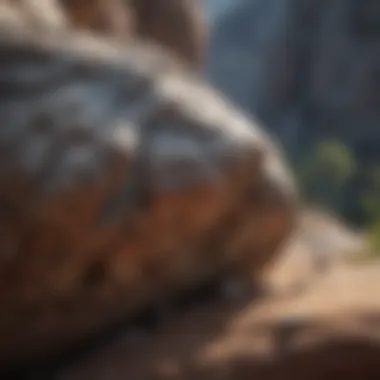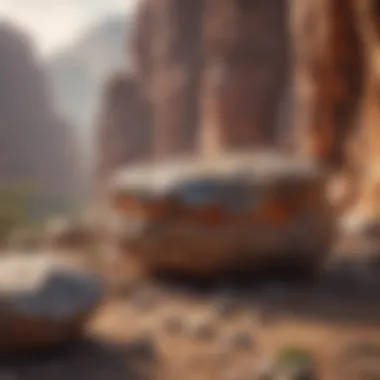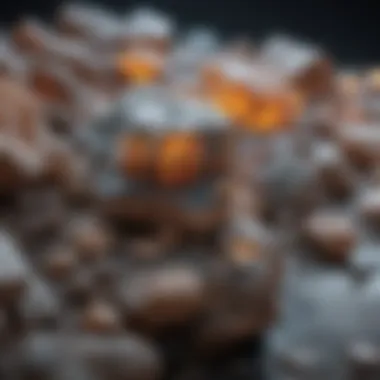Unveiling Intriguing Science Fair Projects Exploring Rocks' Wonders


Nature Topic Overview
Rocks, those sturdy elements that form the foundation of the Earth's crust, hold a mysterious allure that intrigues young geology enthusiasts. Delving into science fair projects centered around rocks unravels a world of geological wonders waiting to be explored.
Fun Facts and Trivia
Engage young minds with fascinating facts about rocks. Did you know that the Earth's crust is made up of various types of rocks, each with its unique characteristics and formation processes? Integrating visuals and interactive elements adds depth to learning, aiding in a better grasp of geological concepts.
Wildlife Explorations
Although rocks may seem inert, they play a crucial role in habitat formation for various wildlife species. By studying how rocks interact with different ecosystems, children can grasp the significance of rocks in supporting biodiversity. Creating interactive features such as quizzes or puzzles further immerses young learners in the interconnectedness of rocks and wildlife.
Environmental Awareness
Understanding the conservation aspect of rocks sheds light on the importance of preserving natural resources. Explore how rock mining impacts the environment and learn practical tips on reducing our ecological footprint. By instilling a sense of environmental responsibility, children can contribute towards sustainability efforts.
DIY Nature Activities
Encourage hands-on learning with DIY projects that involve rocks. From building rock collections to experimenting with rock identification, these activities foster a deeper connection to the natural world. Step-by-step guides for crafting rock-based projects provide children with a creative outlet for their newfound geological knowledge.
Introduction
The exploration of science fair projects focusing on rocks is a venture into the fascinating realm of geology. Understanding rocks not only provides insights into Earth's history but also allows for hands-on learning experiences that can spark curiosity and critical thinking in young minds. These projects offer a unique blend of education and fun, making them an ideal choice for budding geologists to delve deeper into the world beneath our feet.


Understanding Rocks
Types of Rocks
Rocks can be classified into three main categories: igneous, sedimentary, and metamorphic. Each type represents a distinct geological process, with igneous rocks forming from the cooling of molten magma, sedimentary rocks accumulating from the compression of sediments, and metamorphic rocks arising from the transformation of existing rock types under heat and pressure. Examining the types of rocks enables students to comprehend the diverse origins and characteristics of earth materials, fostering a holistic understanding of geology in the science fair projects about rocks.
Composition of Rocks
The composition of rocks encompasses minerals, organic matter, and other elements that constitute the rock's structure. Different rocks exhibit varying compositions based on the minerals present, providing essential clues about their formation and geological history. By analyzing rock composition, young geologists can unravel the intricate processes that shaped the Earth over millennia, gaining valuable insights into the chemical and physical properties of rocks showcased in their science fair projects.
Rock Cycle
The rock cycle illustrates the continuous transformation of rocks through various geological processes such as weathering, erosion, sedimentation, and metamorphism. It showcases the dynamic interplay between different rock types, highlighting the interconnected nature of Earth's geological systems. Understanding the rock cycle is crucial for students embarking on science fair projects about rocks, as it elucidates the cyclical nature of rock formation and alteration, portraying a comprehensive view of the Earth's geology and the forces that shape its surface.
Ideas for Science Fair Projects
In the realm of science fair projects about rocks, the section on 'Ideas for Science Fair Projects' serves as a pivotal point in this article. This segment is crucial as it unveils a plethora of stimulating projects that not only foster a profound understanding of geology but also ignite curiosity and enthusiasm among young learners. By focusing on hands-on activities such as 'Rock Identification' and 'Rock Erosion Simulation,' students are encouraged to delve into the intricate world of rocks actively. These projects provide a holistic approach to learning, incorporating elements of observation, experimentation, and analysis, thereby enhancing the participants' scientific acumen. Furthermore, delving into these projects equips students with essential skills like critical thinking, problem-solving, and data interpretation, all of which are invaluable in their academic pursuits and beyond.
Rock Identification
Methods for Identifying Rocks
Within the 'Rock Identification' subsection, an integral aspect is the discussion on 'Methods for Identifying Rocks.' This focuses on the specific techniques and procedures employed in distinguishing different types of rocks based on their physical characteristics. The significance of this lies in honing students' observational skills and understanding the unique properties that define various rock specimens. By exploring methods such as visual inspection, hardness tests, and chemical analysis, participants not only learn how to differentiate rocks but also comprehend the geological processes that contribute to their formation. The practical application of these methods not only reinforces classroom theories but also fosters a deeper appreciation for the Earth's diverse geological formations.


Creating a Rock Collection
Another key component under 'Rock Identification' is 'Creating a Rock Collection.' This activity involves the curation and organization of different rock samples, thereby enabling students to build a comprehensive repository for further study. By assembling a diverse collection, participants gain exposure to a wide range of rocks, each with its distinct characteristics and origins. This process not only cultivates a sense of ownership and pride in their collection but also promotes a systematic approach to categorizing and cataloging geological specimens. Furthermore, through the creation of a rock collection, students develop valuable skills in research, documentation, and presentation, essential for effective scientific communication and knowledge dissemination.
Rock Erosion Simulation
Understanding Erosion Processes
Moving on to the 'Rock Erosion Simulation' segment, a critical focus lies on 'Understanding Erosion Processes.' This aspect delves into the mechanisms by which natural forces like wind, water, and ice gradually wear down rocks over time. By simulating erosion through hands-on activities and experiments, participants gain a practical insight into the transformative effects of these processes on geological formations. Understanding erosion not only sheds light on the gradual changes in landscapes but also underscores the dynamic interaction between geology and environmental factors. Through this simulation, students develop a profound appreciation for the Earth's dynamic nature and the continued role erosion plays in shaping our planet's topography.
Building an Erosion Model
Complementing the exploration of erosion processes is the activity of 'Building an Erosion Model.' Participants are tasked with constructing physical models that replicate erosion scenarios, allowing them to observe firsthand the impact of different variables on rock structures. By engaging in this hands-on exercise, students enhance their spatial reasoning skills and conceptual understanding of erosion dynamics. Moreover, building erosion models fosters creativity and innovation as participants devise unique ways to mimic natural erosion processes within a controlled environment. Through this tactile experience, students not only deepen their understanding of geological phenomena but also cultivate a curiosity for exploring the broader implications of erosion on landscapes and ecosystems.
Experimentation and Data Analysis
Experimentation and Data Analysis play a pivotal role in the realm of science fair projects about rocks. It serves as the cornerstone for understanding and verifying the hypotheses formulated during the experimental process. By engaging in experimentation, young scientists can explore the tangible outcomes of their research, fostering a deeper comprehension of geological concepts. Data analysis, on the other hand, enables participants to interpret and draw meaningful conclusions from the results obtained. Through meticulous data evaluation, budding geologists can uncover patterns, trends, and anomalies, enhancing the overall learning experience. Emphasizing these aspects ensures a robust scientific approach and cultivates critical thinking skills among participants. Experimentation and Data Analysis instill a sense of methodical inquiry and analytical reasoning, setting the stage for a comprehensive exploration of rocks and geology.
Presentation and Display: Creating an impactful and visually appealing display is crucial when showcasing science fair projects about rocks. This section focuses on the significance of presentation and display elements that highlight the key findings of the projects effectively. By incorporating engaging visuals, concise information, and creative layouts, participants can capture the attention of viewers and communicate their research findings efficiently. Moreover, an attractive display can enhance the overall learning experience for both the presenter and the audience, making the scientific concepts more accessible and memorable.
Creating a Geological Poster:
Visual Presentation Tips:


Visual Presentation Tips play a pivotal role in the effectiveness of a geological poster. These tips guide on utilizing color schemes, fonts, and layout designs to create a visually engaging and informative poster. By employing eye-catching visuals and clear, concise text, the poster can effectively convey complex geological information in a simplified manner. Visual Presentation Tips ensure that the audience can grasp the essence of the project at a glance, enhancing the overall impact and memorability of the presentation.
Including Key Facts:
Including Key Facts within a geological poster is essential to provide a comprehensive overview of the project. These key facts serve as the backbone of the poster, offering vital information concisely and prominently. By incorporating key facts strategically, the audience can quickly understand the project's objectives, methods, and results. Including key facts enhances the poster's credibility and educative value, enabling viewers to grasp the essence of the research effortlessly.
Building a Rock Model:
Choosing Materials:
Selecting appropriate materials for building a rock model is crucial for its accuracy and durability. The choice of materials should reflect the properties and characteristics of the rocks being represented. By opting for materials that mimic the texture, color, and composition of rocks, the model can provide a realistic representation for educational purposes. Selecting materials with varying hardness and texture allows for a hands-on learning experience, enhancing the understanding of rock formations and structure.
Assembling the Model:
Assembling the rock model requires attention to detail and precision to ensure its authenticity. The process of assembling involves arranging the chosen materials in a manner that replicates natural rock formations accurately. By following a systematic approach and referring to geological references, the model can showcase various rock types and formations realistically. Assembling the model enables participants to explore the intricate details of rocks and their geological significance, fostering a deeper appreciation for the subject.
Conclusion
In the realm of science fair projects about rocks, the importance of the Conclusion section cannot be overstated. This segment serves as the culmination of the entire exploration, offering a platform to synthesize the findings and insights gained throughout the project. The Conclusion provides a moment of reflection for the young geology enthusiasts, enabling them to consolidate their learnings and appreciate the significance of their work. By emphasizing the key takeaways and discoveries, the Conclusion enhances the educational value of the project, encouraging participants to delve deeper into the fascinating world of geology.
Reflecting on the Learning Experience
Impact of the Projects
The Impact of the Projects section plays a pivotal role in showcasing the practical application of geological knowledge gained through hands-on exploration. By engaging in activities like rock identification and erosion simulation, participants not only enhance their scientific reasoning and observation skills but also develop a profound appreciation for the Earth's geological processes. The impact of these projects extends beyond the science fair, nurturing a lasting curiosity for geology and inspiring future scientific pursuits. One of the key characteristics of the Impact of the Projects is its ability to instill a sense of discovery and wonder, motivating young learners to actively engage with natural phenomena. This particular aspect makes it a valuable and popular choice for enhancing geology education in a dynamic and interactive manner.
Future Exploration in Geology
Delving into Future Exploration in Geology propels young minds towards a deeper understanding of the subject and fosters a sense of curiosity for ongoing scientific inquiry. By contemplating potential avenues of exploration within the field of geology, participants are encouraged to envision themselves as future geologists and earth scientists. This section highlights the importance of continuous learning and discovery, emphasizing the dynamic nature of geology and the multitude of opportunities available for those passionate about the Earth sciences. An advantageous feature of Future Exploration in Geology is its capacity to inspire long-term interest in geology, laying the foundation for sustained exploration and study in this multifaceted field. While it presents challenges in terms of complexity and depth, the section serves as a catalyst for intellectual growth and scientific engagement, positioning participants on a path of lifelong learning and discovery.







